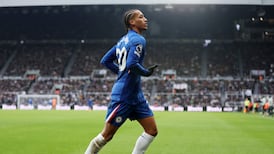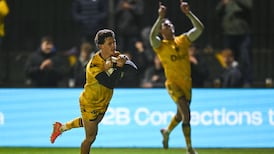In 1978, the car rental giants Hertz wanted to create an advertising campaign framed around the theme of speed of service. The original concept – a businessman sprinting through a generic airport before exiting in a Hertz car – was radicalised to instead show football star OJ Simpson dashing with his briefcase through the airport corridors as a chorus of other travellers – a little old lady, a classical music boffin in bow-tie, a group of school girls – cheered him on with the affirmative "Go OJ, go".
White 1970s America had fallen in love with Simpson because of his ability to run with a football with more grace and elusiveness than anyone else. Last summer, former Hertz chef executive Frank Olsen took on a beatific look as he remembered the once-in-a-career pleasure of presiding over a 40-second clip which bottled the rare combination of clear corporate message and advertising bewitchment. "I thought it was perfect," he said.
Anyone trying to grapple with the reasons for the malevolent, strained turn which America has taken over the past year should make time to watch OJ: Made In America, the seven-and-a-half hour ESPN documentary film directed by Ezra Edelman which is going to win an Academy Award next weekend.
The Hertz advert represented a revolutionary moment in the television age in that it was the first time that corporate America had used an African-American face to endorse a product aimed at primarily at white America. “To us, OJ was colourless,” Olsen explained.
That statement gets to the heart of Simpson's impossible attempt to all but shed his skin as he excelled as a handsome, sunny football phenomenon at USC (nicknamed OJC by Bob Hope) and, later, the Buffalo Bills. His emergence as a television-friendly star coincided with an intensifying decade of civil rights awareness but Simpson decided he wanted no part of the defiant stance taken by other African-American sports stars like Muhammad Ali, Jim Brown and Lew Alcindor.
Racial divide
Simpson aspired to join the elite stratosphere of white celebrity society in Los Angeles and chose to believe he could transcend the racial divide, that he could float above that reality as easily as he seemed to glide over the football fields of the NFL. The Hertz advert represented a point of no return and he used his face, the lustre of his athletic accomplishment, a seemingly pathological capacity to charm and his instinctive intelligence of what people wanted him to be in order to move from sports into television and film.
"I was pulled into it once or twice in the black movement in school and I think they tried to use us in many cases," he says in an archived interview. "It hurt us. It hurt Tommy Smyth. It hurt John Carlos. Standing on his platform – he should have stood on his own. And I said if I'm gonna stand on a platform, I'm gonna be speaking for OJ Simpson."
Civil rights leaders in Los Angeles and childhood friends like Joe Bell from the San Francisco housing project where Simpson grew up dismissed him as a lost cause. Bell would recall visiting Simpson in Brentwood and watching his friend playing tennis in a rarefied suburban setting straight out of a John Cheever story. They were not only the only two black men in the company, they were close to being the only two black men in the entire area not hired to do menial labour. Bell told Simpson that those people wouldn't want anything to do with him if he wasn't OJ. "But I am OJ," came the laughing reply.
In the 20th century, sport was one of the few pathways to progression and young African-American men were actively recruited by the establishment.
The dismay and disdain felt by his contemporaries at the path he chose is understandable. But there was something extraordinarily eccentric and singular in how Simpson tried to view the America he inherited: as a land in which segregation between blacks and whites didn’t exist – at least for him. His mantra was that his being black was an irrelevance, he wanted to make it as an American full stop and through brokering friendships with the white affluent set – “I brought him places where very few black people had been,” Frank Olsen said – he must have felt, for a few years, as if he had made it.
What Simpson tried to do, in other words, was to block out the steep challenges and disadvantages which, for many millions of people, came with being born as African-American in the 16 post-slavery decades, through which the legacy of white preservationist society has continued to travel and travel, through OJ’s golden period of the ’70s, through the ’80s and right through until the bleak, bizarre Trump era in which America finds itself today.
In the 20th century, sport was one of the few pathways to progression and young African-American men were actively recruited by the establishment. Pro sport – first boxing, later the ball sports – represented an escape plan for many thousands. Only a small percentage made it through and none of those were accorded the level of adoration directed at Simpson.
Horrific murder
For understandable reasons, Simpson's life story has been reduced to the circumstances around the horrific murder of his former wife Nicole Brown and her companion, Ron Goldman. The lurid nature of those murders and Simpson's trial arrived at a time when the black communities of Los Angeles were caught between rage and despair at the sense that nobody in their community could get a fair hearing from the US justice system.
The acquittal of the police officers charged with assault on Rodney King provoked mass riots in 1992 but a year earlier in LA, an African-American teenage girl named Latasha Harlins was shot in the back and killed by a Korean grocer who had – as CCTV would show – wrongly accused the girl of attempting to steal a bottle of orange juice. The court gave the girl's killer a suspended sentence.
When Simpson stood up to plead not guilty in the most dramatised, reality-televised court case in legal history, the entire case quickly separated into perspectives based on whether one was a white American or an African-American. So it was his own murder trial which made clear to Simpson the extent of the fabrication he had created for himself : it was then that he understood that he would never be seen as anything other than black.
Simpson was, of course, acquitted but the trial had unmasked a shocking, violent side to his personality. He was ejected from country club America and his slide into National Enquirer notoriety was as gradual as his climb to the first tier of American achievement had been swift. He was sentenced to 30 years in 2008, just months after Barack Obama was elected to the White House.
In March of that year, in a famous speech delivered on race in Philadelphia, Obama referred to the pointlessness of tackling “race as spectacle, as we did in the OJ trial”. It is fascinating to read that speech now, from the distance of eight years, as Obama grapples with the complexities and contradictions of race.
The surge of optimism generated by Obama’s election seemed, in 2008, like a dazzling breakthrough; a decisive step forward in the aspiration to find “a more perfect union” between the races. The counter-rush towards Trump last November will just reinforce old stereotypes and tensions and prolong the divide.
That’s why OJ Simpson’s Hertz advert is so haunting to look at now. It was, for small self-motivated reasons notwithstanding, a literal attempt to outrun the very issue of race and leave it behind. As it turned out, nobody in America is that fast.











